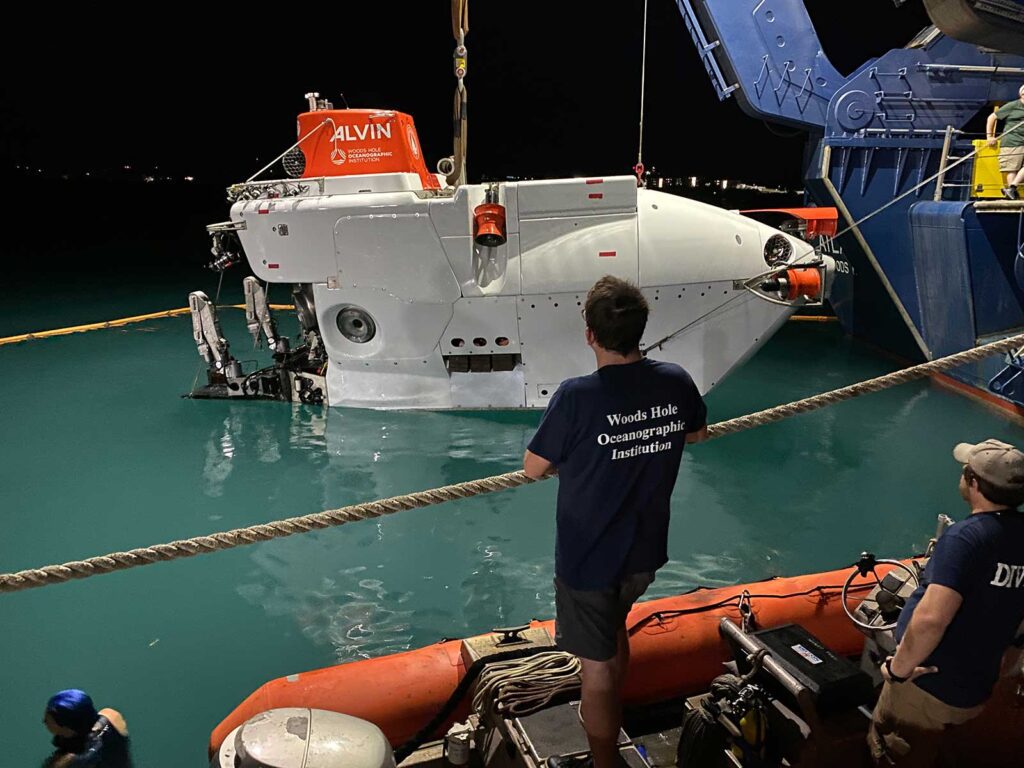
The deep-diving Human Occupied Vehicle Alvin is being certified for return to service following completion of a series of modernization and improvements. Alvin is currently undergoing certification dives near Bermuda.
Thanks to Alvin’s three-inch-thick titanium sphere, researchers can study the deep ocean while safe from the crushing pressure and deadly cold.
Alvin is owned by the U. S. Navy Office of Naval Research and operated by the National Deep Submergence Facility (NDSF) at Woods Hole Oceanographic Institution (WHOI) and was last certified in 2013 to dive to 4,500 meters. Although a $50 million overhaul was conducted between 2011 and 2013, some of the necessary improvements to certify the vehicle to conduct deeper dives were not yet available. An $8 million upgrade was commenced last year. Alvin’s upgrade and operations are largely funded by the National Science Foundation.
According to Andy Bowen, a principal engineer of applied ocean physics and engineering at WHOI and director of the NDSF, the most recent overhaul will extend Alvin’s depth certification from 4,500 to 6,500 meters.
“This increase in depth capability involves a wide range of improvements from a new titanium personnel sphere, variable ballast system, hydraulic power plant and upgraded floatation,” he said. “There has also been a myriad of improvements to the vehicle’s propulsion system, imaging capabilities and overall electronic upgrades.
“We are engaged in the early stages of sea trials to verify performance of all the vehicle systems, including life support, stability, variable ballast, manipulation and hydraulic components,” Bowen said. “Progress in verifying perforce has been steady with initial dives tethered to the support vessel RV Atlantis accomplished with satisfactory results. We expect to complete the first untethered dives this week in the harbor here in St. Georges, Bermuda. Once this has been accomplished, Atlantis and Alvin will move into open ocean and continue with a series of deeper dives until we have achieved our full depth of 6,500 meters.”
Alvin will make its first 6,500-meter dive, or 21,325 feet — nearly four miles below the ocean’s surface — in mid-November. It takes about three and a half hours to reach that depth. Missions can last as long as 10 hours, although most missions do not travel to the vehicle’s maximum depth.
Atlantis completed its own one-year, $50 million overhaul in July.
“We planned to do the one-year refit of Atlantis to coincide with the work on Alvin, so the mothership and sub would be done in parallel,” said Tim Schnoor, a contractor supporting ONR’s research ship programs. “The work on Atlantis included improvements to and recertification of Alvin’s launch and recovery system, and the upgrades to the storage hangar where Alvin is kept between missions.”
Brian Pelletier, assistant program manager for advanced undersea systems at Naval Sea Systems Command (NAVSEA), said the certification process will ensure Alvin can be operated safely with people on board. “We ensure the system is safe for manned operations per the manual for deep submergence systems. Our NAVSEA team has been observing the November test dives in the Bahamas, and engineers from Team SUB will provide independent representatives to make sure the tests are being performed in accordance with the requirements of NAVSEA P9290, which is the Navy’s system certification procedures and criteria manual for deep submergence systems.”
After the certification dives, Bowen said Alvin will move into a brief series of test dives to prove its scientific capabilities in the waters around Puerto Rico. “With these accomplished, Alvin’s first scientific dives will be in support for Dr. Craig Young from the University of Oregon,” he said.
Alvin usually operates with a pilot and carries two scientists, and can be fitted with the appropriate instruments and science payload for the mission being conducted.
ONR is responsible for acquisition and life cycle support, with funding also provided by the National Science Foundation and the National Oceanic and Atmospheric Administration. Alvin’s operations are managed by the NDSF and scheduling is coordinated by the University-National Oceanographic Laboratory System.
In addition to Alvin, the NDSF also operates the Navy-owned remotely operated vehicle Jason and autonomous underwater vehicle Sentry for the ocean science community.
While researchers can learn a lot from unmanned systems, Bowen said there is no substitute for the human. “Humans are still the most effective means for exploring the unknown,” he said.
- A Day to Remember - September 11, 2023
- Indo-Pacific Maritime Security Exchange will examine emerging capabilities and capacity - July 12, 2023
- Cold Waters Spark Warm Relationship - April 20, 2023






